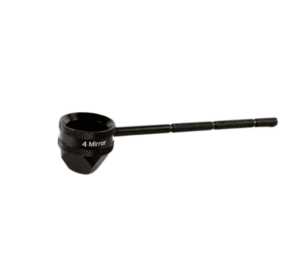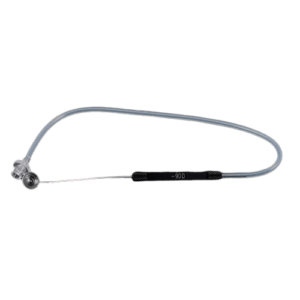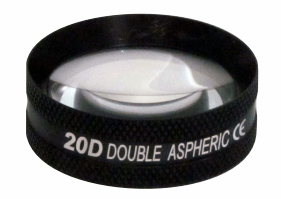In the vast landscape of medical advancements, few fields have undergone a transformation as remarkable as that of ophthalmology. With the advent of diagnostic and surgical lenses, a visionary revolution has taken place, reshaping the way we perceive and address ocular conditions. These remarkable devices have not only revolutionized diagnostics allowing us to peer deeper into the eye than ever before but they have also empowered surgeons to perform intricate procedures with unparalleled precision.
Diagnostic and surgical lenses have revolutionized the field of ophthalmology enabling healthcare professionals to examine the eye in unprecedented detail and perform intricate procedures with exceptional precision. Diagnostic lenses have played a pivotal role in identifying and assessing various ocular conditions, while surgical lenses act as a guiding hand for surgeons, offering magnification, illumination, and augmented visualization. These lenses have transformed the way we diagnose, monitor and manage ocular disorders pushing the boundaries of what can be achieved in ophthalmic surgery and promising improved outcomes for patients.
In this exploration of the visionary revolution in diagnostic and surgical lenses, we will delve into the advancements and the transformative impact of these remarkable devices. We will witness how these lenses have transcended mere optical aids, becoming indispensable instruments that empower medical professionals to shape the future of ocular care.
Join us on this journey as we traverse the ever-evolving landscape of diagnostic and surgical lenses illuminating the past celebrating the present and anticipating the boundless possibilities that lie ahead. Together, we will marvel at the visionary revolution unfolding before our eyes and explore the profound impact it has on the world of ophthalmology.
Understanding Diagnostic & Surgical Lenses
Diagnostic lenses are specialized tools utilized by ophthalmologists to thoroughly examine the various structures and overall health of the eye. These optical devices are designed to provide a detailed and comprehensive evaluation allowing healthcare professionals to gain valuable insights into the condition of the eye and make accurate diagnoses. These lenses come in various forms such as slit lamps, ophthalmoscopes, retinoscopes and biomicroscopes.
They are designed to provide magnification and illumination allowing for detailed visualization and assessment of ocular structures including the cornea lens iris retina and optic nerve. They are instrumental in identifying and assessing a diverse range of issues including common refractive errors like nearsightedness and astigmatism as well as more complex retinal diseases. These lenses enable healthcare professionals to gain valuable insights into the health of the eye empowering them to provide appropriate and effective treatment strategies.
Surgical lenses also known as intraocular lenses (IOLs) are specialized optical implants used during ophthalmic surgeries, particularly procedures involving the lens of the eye. They are from materials that are safe for the human body these lenses are specifically designed to serve as a replacement for the natural lens of the eye. They are beneficial in cases where the natural lens has been affected by conditions such as cataracts or refractive errors. By seamlessly taking on the role of the natural lens these lenses help restore clear vision and improve overall visual function. Surgical lenses can correct vision impairments, improve visual acuity, and restore clarity to the eye.
They are precisely implanted within the eye during procedures such as cataract surgery or refractive lens exchange, and their selection and positioning depend on various factors, including the patient’s visual needs and the specific characteristics of their eye. Surgical lenses provide clear vision and contribute to improved outcomes and an enhanced quality of life for patients undergoing ophthalmic surgery.
Types of Diagnostic & Surgical Lenses
Diagnostic Lenses
- Slit Lamp Lens: A lens used with a slit lamp biomicroscope to examine the anterior segment of the eye, including the cornea, iris, and lens.
- Indirect Ophthalmoscope Lens: A lens used with an indirect ophthalmoscope to view the posterior segment of the eye including the retina and optic nerve.
- Fundus Lens: A lens used to visualize the back of the eye and examine the retina, optic disc, and blood vessels in detail.
- Gonioscopy Lens: A lens used to assess the angle of the anterior chamber of the eye, particularly important in the diagnosis and management of glaucoma.
- Retinoscopy Lens: A lens used in retinoscopy, a technique to objectively measure a patient’s refractive error by observing the movement of light reflexes in the eye.
Surgical Lenses (Intraocular Lenses – IOLs)
- Monofocal IOLs: These lenses provide clear vision at a fixed focal distance, usually for distance vision. Patients may still require glasses for near or intermediate vision.
- Multifocal IOLs: These lenses incorporate multiple focal points, allowing patients to have clear vision at various distances, reducing the need for glasses.
- Toric IOLs: These lenses are specifically designed to correct astigmatism, providing clearer vision by addressing the irregular corneal curvature associated with this condition.
- Accommodating IOLs: These lenses mimic the natural lens of the eye, providing a dynamic range of focus and allowing patients to have clearer vision at different distances.
- Phakic IOLs: These lenses are implanted without removing the natural lens and are primarily used to correct severe refractive errors, such as high myopia or hyperopia.
- EDOF (Extended Depth of Focus) IOLs: These lenses provide an extended range of clear vision reducing dependence on glasses for both distance and intermediate tasks.
Uses of Diagnostic & Surgical Lenses
Uses of Diagnostic Lenses are:
- Refraction Assessment: Diagnostic lenses are essential for determining a patient’s refractive error including nearsightedness farsightedness and astigmatism. These lenses help eye care professionals measure the exact prescription needed for glasses or contact lenses.
- Ocular Disease Diagnosis: Diagnostic lenses enable healthcare professionals to examine the structures of the eye, diagnose various ocular conditions, and monitor their progression. They are used to assess conditions such as cataracts glaucoma macular degeneration diabetic retinopathy and other retinal disorders.
- Contact Lens Fitting: Diagnostic lenses are used to evaluate the fit and suitability of contact lenses for individual patients. These lenses help in assessing the corneal shape, size, and other factors necessary for proper contact lens selection and fitting.
- Anterior Segment Evaluation: Lenses such as slit lamp lenses and biomicroscopy lenses are used to examine the front part of the eye, including the cornea, conjunctiva, iris, and lens. They help in the diagnosis and monitoring of conditions like corneal ulcers conjunctivitis and anterior uveitis.
- Posterior Segment Evaluation: Diagnostic lenses such as indirect ophthalmoscope lenses and fundus lenses allow healthcare professionals to visualize and evaluate the structures of the posterior segment of the eye including the retina optic nerve and blood vessels.
By utilizing these lenses healthcare professionals can accurately assess the severity and progression of these conditions allowing for timely and appropriate treatment interventions.
Uses of Surgical Lenses (Intraocular Lenses – IOLs) are:
- Cataract Surgery: Surgical lenses are used in cataract surgery to replace the clouded natural lens of the eye with a clear artificial lens. This improves vision by restoring clarity and focusing power to the eye.
- Refractive Lens Exchange: Surgical lenses can be used in refractive lens exchange RLE procedures to correct refractive errors such as nearsightedness farsightedness and presbyopia. The natural lens is replaced with an intraocular lens to achieve better vision.
- Astigmatism Correction: Toric intraocular lenses are specifically designed to correct astigmatism during cataract or refractive lens exchange surgeries. These lenses address the irregular corneal curvature and provide clearer vision.
- Presbyopia Correction: Multifocal and accommodating intraocular lenses are used to address presbyopia, a condition where the natural lens loses its ability to focus on near objects. These lenses provide a range of clear vision, reducing dependence on reading glasses.
- Phakic Lens Implantation: Phakic intraocular lenses are used in cases of high myopia or hyperopia when the natural lens is left in place. These lenses are implanted to correct the refractive error and reduce the patient’s dependence on glasses or contact lenses.
- Ophthalmic Diagnostic Lenses: These specialized lenses are used in various ophthalmic diagnostic instruments such as corneal topographers autorefractors and optical coherence tomography OCT systems. They allow for precise measurements, imaging, and evaluation of ocular structures for accurate diagnosis and treatment planning.
- Endoscopic Surgical Lenses: Endoscopic lenses are used in surgical procedures such as endoscopic sinus surgery. These lenses provide enhanced visualization and magnification, enabling surgeons to perform delicate procedures with greater precision.
- Retinal Imaging Lenses: Lenses designed for retinal imaging techniques such as fundus photography fluorescein angiography and optical coherence tomography OCT allow for detailed visualization of the retina and aid in the diagnosis and monitoring of retinal diseases.
- Microscopy Lenses: Microscopy lenses are used in ophthalmic research laboratory settings and specialized clinical examinations. These lenses provide high-resolution magnification for studying cellular structures, conducting histological examinations, and performing advanced research in ophthalmology.
These various types of diagnostic and surgical lenses serve critical roles in vision correction, disease diagnosis, surgical procedures, and ophthalmic research. They contribute to the advancement of ophthalmology enabling precise diagnostics improved surgical outcomes and enhanced understanding of ocular health and diseases.
Benefits of Diagnostic & Surgical Lenses
The benefits of Diagnostic & Surgical Lenses are:
- Enhanced Visualization: Diagnostic lenses, including high-resolution diagnostic lenses, provide healthcare professionals with detailed and magnified views of ocular structures. This allows for accurate diagnosis and monitoring of various eye conditions, leading to more effective treatment plans.
- Precise Refractive Measurements: Diagnostic lenses play a crucial role in obtaining precise refractive measurements, helping eye care professionals determine the exact prescription needed for glasses or contact lenses. This ensures optimal visual correction for patients.
- Early Detection and Intervention: Diagnostic lenses enable early detection of ocular diseases and abnormalities. By using advanced diagnostic tools and lenses healthcare professionals can identify conditions such as cataracts glaucoma and retinal diseases at their earliest stages. This facilitates timely intervention and better outcomes.
- Improved Surgical Outcomes: Advanced surgical lenses offer benefits such as magnification, illumination, and augmented visualization. These features enhance surgeons’ precision, allowing for more accurate and effective procedures. Surgical lenses, including customizable lenses, help achieve personalized surgical outcomes tailored to each patient’s needs.
- Minimally Invasive Procedures: Surgical lenses, particularly those used in minimally invasive procedures such as endoscopic surgery, enable surgeons to perform intricate surgeries through small incisions. This results in reduced trauma, faster recovery times, and minimal scarring for patients.
- Optimal Vision Correction: Surgical lenses, such as intraocular lenses (IOLs), provide precise vision correction for patients undergoing cataract surgery or refractive lens exchange. These lenses can address various refractive errors, including astigmatism, presbyopia, and high myopia, offering patients clearer and improved vision.
- Customization and Personalization: Customizable lenses, both in diagnostic and surgical applications, allow for personalized treatment approaches. Healthcare professionals can tailor the lenses to meet specific patient needs, optimizing visual outcomes and patient satisfaction.
- Technological Advancements: The continuous advancements in diagnostic and surgical lens technology have led to improved imaging capabilities, greater precision, and enhanced surgical techniques. These advancements have revolutionized the field of ophthalmology, offering better diagnostic accuracy and surgical outcomes.
- Research and Innovation: Diagnostic lenses, such as retinal imaging lenses and microscopy lenses, facilitate ophthalmic research, providing high-resolution images and insights into ocular structures. This research drives innovation, leading to the development of new diagnostic tools, surgical techniques, and lens designs.
In summary, diagnostic and surgical lenses offer a range of benefits, including enhanced visualization, precise refractive measurements, early disease detection, improved surgical outcomes, customization, and contribution to research and innovation. These lenses play a vital role in the field of ophthalmology enabling accurate diagnoses personalized treatments and better visual outcomes for patients.
Diagnostic & Surgical Lenses From Leading Indian Manufacturers
DP-5085 Diagnostic Aspherical Lens Double
DP-5085 Diagnostic Aspherical Lens Double , produced by Kashmir Surgical India Pvt. Ltd., is a top-quality lens designed to address field curvature and astigmatic aberrations. This lens ensures exceptional performance for diagnostic and laser purposes.
Available in two variants, namely 78D and 90D, both equipped with aspheric lenses, the DP-5085 Lens guarantees accurate diagnoses and optimal visualization during examinations. Trusted by medical professionals worldwide, its craftsmanship and reliability make it a preferred choice.
ASF 4-Mirror Gonio Lens
 Introducing the ASF 4-Mirror Gonio Lens by A.S.F. Universal, a renowned diagnostic and surgical lens in India. With its four mirrors providing a wide 62° angle, this versatile lens enables clear visualization of the anterior chamber from all four quadrants, eliminating the need for rotation. Its compact design with a small 9 mm contact surface ensures ease of use and patient comfort. The lens’s detachable handle and absence of coupling fluid add to its practicality and efficiency during anterior chamber examinations.
Introducing the ASF 4-Mirror Gonio Lens by A.S.F. Universal, a renowned diagnostic and surgical lens in India. With its four mirrors providing a wide 62° angle, this versatile lens enables clear visualization of the anterior chamber from all four quadrants, eliminating the need for rotation. Its compact design with a small 9 mm contact surface ensures ease of use and patient comfort. The lens’s detachable handle and absence of coupling fluid add to its practicality and efficiency during anterior chamber examinations.
Opticlear Irrigating Vitrectomy Lens Set
 Madhu Instruments Pvt. Ltd. presents the Opticlear Irrigating Vitrectomy Lens Set., a comprehensive kit consisting of three high-quality glass lenses designed for vitrectomy procedures. These lenses offer exceptional image clarity, ensuring precise visualization during surgeries.
Madhu Instruments Pvt. Ltd. presents the Opticlear Irrigating Vitrectomy Lens Set., a comprehensive kit consisting of three high-quality glass lenses designed for vitrectomy procedures. These lenses offer exceptional image clarity, ensuring precise visualization during surgeries.
Featuring engraved descriptions on the handles for easy identification, the Opticlear Irrigating Vitrectomy Lens Set allows medical professionals to quickly select the desired lens during procedures. Individual lens ordering provides flexibility, allowing surgeons to acquire specific lenses tailored to their surgical needs. With its innovative design and superior performance, this lens set is the preferred choice for surgeons conducting vitrectomies.
This description incorporates essential keywords like “Diagnostic Aspherical Lens Double,” “Gonio Lens,” and “Irrigating Vitrectomy Lens Set.” It also highlights the manufacturers’ names, Kashmir Surgical India Pvt. Ltd., A.S.F. Universal, and Madhu Instruments Pvt. Ltd. By focusing on the provided description and features, the rephrased content provides concise yet informative details about each product, optimizing search engine ranking.
The Medzell Advantage: Pioneering the Future of Medical Devices
As we embrace the fascinating world of diagnostic and surgical lenses, it is worth mentioning Medzell, is an innovative business-to-business (B2B) platform with a forward-looking approach, aimed at promoting Indian medical devices within emerging markets. Medzell stands at the forefront of innovation, connecting healthcare professionals with cutting-edge technologies and fostering collaborations that drive healthcare excellence. With their unwavering commitment to quality and efficiency, Medzell is poised to revolutionize the accessibility and distribution of medical devices, including diagnostic and surgical lenses.
At Medzell, the future is now, as they strive to bridge gaps, amplify possibilities, and empower healthcare professionals worldwide with visionary tools and technologies.
Conclusion
The realm of diagnostic and surgical lenses continues to push the boundaries of medical care, propelling us toward a future where precision, vision, and patient outcomes intertwine seamlessly. From ophthalmic diagnostics to high-resolution imaging, these lenses have become indispensable in ensuring accurate diagnoses, enhanced surgical precision, and improved patient outcomes. As we celebrate the remarkable advancements in surgical lens technology, let us not forget the crucial role of diagnostic lenses in paving the way for optimal medical care. Embrace the power of these lenses and join us on this visionary revolution, where accuracy, innovation, and compassionate patient care unite to shape a brighter future.



